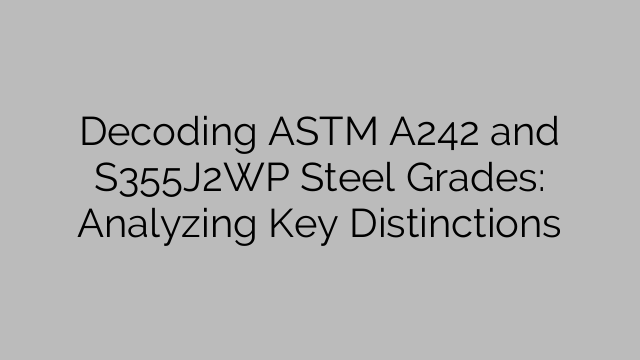Decoding ASTM A242 and S355J2WP Steel Grades: Analyzing Key Distinctions
When it comes to steel grades, there is a wide range of options available, each with its own unique properties and applications. Two commonly used grades in structural engineering are ASTM A242 and S355J2WP. While they may appear similar at first glance, a closer look reveals some key distinctions that engineers must consider before choosing the right grade for their project.
ASTM A242 and S355J2WP are both weathering steel grades designed to provide excellent corrosion resistance and withstand the effects of harsh weather conditions. Weathering steel, also known as corten steel, forms a protective oxide layer on its surface when exposed to the environment, which prevents further corrosion and enhances its durability. Now, let’s delve deeper into each steel grade to understand their unique characteristics.
ASTM A242, commonly known as ASTM A242 Type 1, is a high-strength low-alloy structural steel renowned for its corrosion resistance. This grade contains copper, chromium, nickel, and other alloying elements, giving it improved atmospheric corrosion resistance compared to ordinary carbon steel. The addition of these elements allows ASTM A242 to develop a stable rust-like appearance over time, which eliminates the need for paint maintenance and enhances its aesthetic appeal. Moreover, this steel grade has high tensile strength, making it suitable for structural applications such as bridges, buildings, and outdoor sculptures.
On the other hand, S355J2WP is a European standard steel grade that falls under the EN 10025-5 standard. This grade is renowned for its enhanced atmospheric corrosion resistance due to the addition of phosphorus, copper, chromium, nickel, and other alloying elements. Unlike ASTM A242, S355J2WP steel does not develop a distinct rust-like appearance but rather a protective patina that helps inhibit further corrosion. This characteristic makes it an excellent choice for outdoor structures, facades, and architectural applications.
While both ASTM A242 and S355J2WP steel grades provide excellent corrosion resistance, the key distinction lies in their chemical compositions. ASTM A242 primarily contains copper, while S355J2WP has a higher copper content along with phosphorus. This variation impacts their corrosion resistance and weathering properties, making it essential to consider specific environmental conditions when selecting the appropriate grade.
Another crucial factor to consider is mechanical properties. ASTM A242 has a minimum yield strength of 50 ksi (345 MPa) and a minimum tensile strength of 70 ksi (483 MPa). On the other hand, S355J2WP has a minimum yield strength of 355 MPa and a minimum tensile strength of 470-630 MPa. These variations in strength should be taken into account when determining the suitability of each grade for specific structural applications.
In conclusion, while ASTM A242 and S355J2WP steel grades are both known for their corrosion resistance and weathering properties, they have crucial distinctions that engineers must consider. ASTM A242 contains copper and offers a distinct rust-like appearance over time, while S355J2WP has a higher copper content and develops a protective patina. Additionally, mechanical properties differ between the two grades. Ultimately, the choice between ASTM A242 and S355J2WP depends on the specific environmental conditions and structural requirements of the project, highlighting the importance of careful evaluation and analysis before making a decision.

